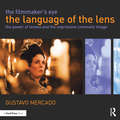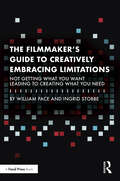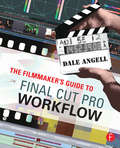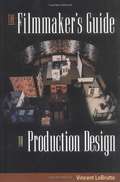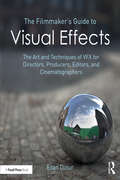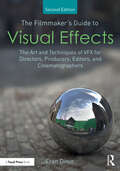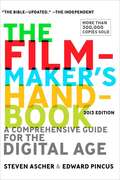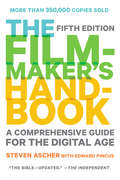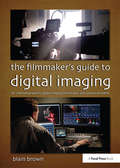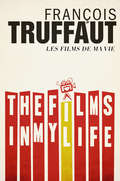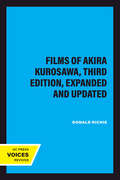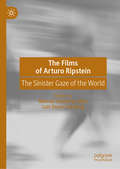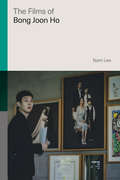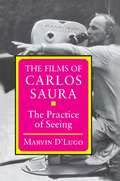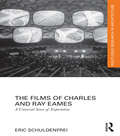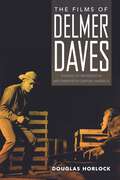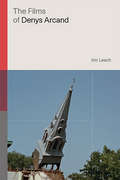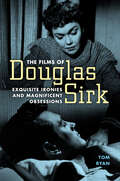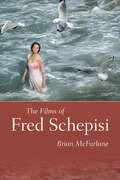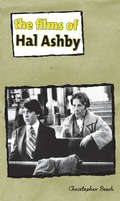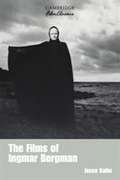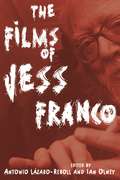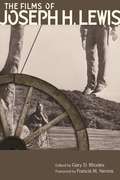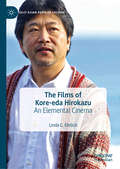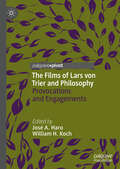- Table View
- List View
The Filmmaker's Eye: The Power of Lenses and the Expressive Cinematic Image
by Gustavo MercadoThe Language of the Lens explores the expressive power of the camera lens and the storytelling contributions that this critical tool can make to a film project. This book offers a unique approach to learning how lenses can produce aesthetically and narratively compelling images in movies, through a close examination of the various ways lens techniques control the look of space, movement, focus, flares, distortion, and the "optical personality" of your story’s visual landscape. Loaded with vivid examples from commercial, independent, and world cinema, The Language of the Lens presents dozens of insightful case studies examining their conceptual, narrative, and technical approaches to reveal how master filmmakers have harnessed the power of lenses to express the entire range of emotions, themes, tone, atmosphere, subtexts, moods, and abstract concepts. The Language of the Lens provides filmmakers, at any level or experience, with a wealth of knowledge to unleash the full expressive power of any lens at their disposal, whether they are shooting with state-of-the-art cinema lenses or a smartphone, and everything in between.
The Filmmaker's Guide to Creatively Embracing Limitations: Not Getting What You Want Leading to Creating What You Need
by William R. Pace Ingrid StobbeStarting out as a filmmaker comes with a host of limitations and restrictions leading to one key question: how do you channel your creativity past these daunting challenges to create compelling and impactful films? Authors William Pace and Ingrid Stobbe advise the key is to not consider them roadblocks to being creative, but opportunities. Providing both historical and contemporary examples, as well as outlining practical exercises filmmakers can apply to their own creative processes, they illustrate how filmmakers can transform obstacles into successes. Looking into limitations and restrictions arising at all stages of the film production process, the book illuminates the importance of developing unique creative muscles and how to apply them to your own work. This is a unique text in the field that provides both a theoretical and practical approach to inspired and savvy filmmaking that uses limitations as points of inspiration. Drawing on examples from artists like Frank Oz, Pete Docter, Gabby Sumney, and Shaun Clarke, filmmakers will gain a well-rounded understanding of the creative processes behind motion picture production and learn how to shape their own independent creative voice when utilizing budget-conscious, creatively aware filmmaking. Foregrounding limitation-embracing strategy and capability, making a film for the first time or with limited resources is no longer overwhelming with this highly practical textbook. Ideal for undergraduate students of film production and first-time filmmakers.
The Filmmaker's Guide to Final Cut Pro Workflow
by Dale AngellThe Filmmaker's Guide to Final Cut Pro Workflow is the comprehensive roadmap to affordable postproduction workflow using Final Cut Pro, Cinema Tools, and Pro Tools. Illuminating workflow and the interrelationship of these software applications, it also focuses on cost saving and efficiency, aiding low-budget, independent moviemakers as well as students trying to take their skills to the professional level.Author Dale Angell offers a practical guide to complete film postproduction workflow, describing low-cost workflow that can be used for 35mm film, High Definition digital video, or DV/Red Camera. The Filmmaker's Guide to Final Cut Pro Workflow will help the independent filmmaker working on a tight budget:. Understand capturing picture when shooting on film or digital video . Finishing the project on either film or video . Audio edit workflows for both film and video . Comprehend NTSC and PAL video as well as modern digital video formats. Understand timecode and the file architecture in Final Cut Pro, Cinema Tools, and Pro Tools
The Filmmaker's Guide to Production Design
by Vincent LoBruttoLearn to turn a simple screenplay into a visual masterpiece! Top production designers share their real-life experiences to explain the aesthetic, narrative, and technical aspects of the craft. Step by step, aspiring filmmakers will discover sound instruction on the tools of the trade, and established filmmakers will enjoy a new outlook on production design. They will learn, for example, the craft behind movie magic-such as how to create a design metaphor, choose a color scheme, use space, and work within all genres of film, from well-funded studio projects to "guerilla filmmaking." This indispensable resource also contains a history of movie making and guidelines for digital production design. For the experienced filmmaker seeking new design ideas to the struggling newcomer stretching low-budget dollars, this book makes the processes and concepts of production design accessible.Allworth Press, an imprint of Skyhorse Publishing, publishes a broad range of books on the visual and performing arts, with emphasis on the business of art. Our titles cover subjects such as graphic design, theater, branding, fine art, photography, interior design, writing, acting, film, how to start careers, business and legal forms, business practices, and more. While we don't aspire to publish a New York Times bestseller or a national bestseller, we are deeply committed to quality books that help creative professionals succeed and thrive. We often publish in areas overlooked by other publishers and welcome the author whose expertise can help our audience of readers.
The Filmmaker's Guide to Visual Effects: The Art and Techniques of VFX for Directors, Producers, Editors and Cinematographers
by Eran DinurThe Filmmaker’s Guide to Visual Effects offers a practical, detailed guide to visual effects for non-VFX specialists working in film and television. In contemporary filmmaking and television production, visual effects are used extensively in a wide variety of genres and formats to contribute to visual storytelling, help deal with production limitations, and reduce budget costs. Yet for many directors, producers, editors, and cinematographers, visual effects remain an often misunderstood aspect of media production. In this book, award-winning VFX supervisor and instructor Eran Dinur introduces readers to visual effects from the filmmaker’s perspective, providing a comprehensive guide to conceiving, designing, budgeting, planning, shooting, and reviewing VFX, from pre-production through post-production. The book will help readers: Learn what it takes for editors, cinematographers, directors, producers, gaffers, and other filmmakers to work more effectively with the visual effects team during pre-production, on the set and in post, use visual effects as a narrative aid, reduce production costs, and solve problems on location; Achieve a deeper understanding of 3D, 2D, and 2.5D workflows; the various VFX crafts from matchmove to compositing; essential concepts like photorealism, parallax, roto, and extraction; become familiar with the most common types of VFX, their role in filmmaking, and learn how to plan effectively for the cost and complexity of VFX shots; See visual effects concepts brought to life in practical, highly illustrated examples drawn from the real-world experiences of industry professionals, and discover how to better integrate visual effects into your own projects.
The Filmmaker's Guide to Visual Effects: The Art and Techniques of VFX for Directors, Producers, Editors and Cinematographers
by Eran DinurThe Filmmaker’s Guide to Visual Effects offers a practical, detailed guide to visual effects for non-VFX specialists working in film and television. In contemporary filmmaking and television production, visual effects are used extensively in a wide variety of genres and formats to contribute to visual storytelling, help deal with production limitations, and reduce budget costs. Yet, for many directors, producers, editors, and cinematographers, visual effects remain an often misunderstood aspect of media production. In this book, award-winning VFX supervisor and instructor Eran Dinur introduces readers to visual effects from the filmmaker’s perspective, providing a comprehensive guide to conceiving, designing, budgeting, planning, shooting, and reviewing VFX, from pre-production through post-production. The book will help readers: Learn what it takes for editors, cinematographers, directors, producers, gaffers, and other filmmakers to work more effectively with the visual effects team during pre-production, on the set, and in post; use visual effects as a narrative aid; reduce production costs; and solve problems on location Achieve a deeper understanding of 3D, 2D, and 2.5D workflows; the various VFX crafts from matchmove to compositing; and essential concepts like photorealism, parallax, roto, and extraction; become familiar with traditional VFX workflows as well as virtual production; and learn how to plan effectively for the cost and complexity of VFX shots See visual effects concepts brought to life in practical, highly illustrated examples drawn from the real-world experiences of industry professionals and discover how to better integrate visual effects into your own projects
The Filmmaker's Handbook 2013: A Comprehensive Guide for the Digital Age
by Steven Ascher Edward PincusThe authoritative guide to producing, directing, shooting, editing, and distributing your video or film. Widely acknowledged as the 'bible' of video and film production, and used in courses around the world, The Filmmaker's Handbook is now updated with the latest advances in HD and new digital formats. For students and teachers, professionals and novices, this indispensable handbook covers all aspects of movie making: <P> * Techniques for making dramatic features, documentaries, corporate, broadcast, and experimental videos and films <P> * Shooting with DSLRs, video, film, and digital cinema cameras <P> * Digital editing with the latest video editing systems <P> * In-depth coverage of lenses, lighting, sound recording, and mixing <P> * The business aspects of funding and producing your project * <P> * Getting your movie shown in theaters, on TV, and on the Web
The Filmmaker's Handbook: A Comprehensive Guide for the Digital Age
by Steven Ascher Edward PincusThe authoritative guide to producing, directing, shooting, editing, and distributing your video or film Widely acknowledged as the "bible" of video and film production, and used in courses around the world, The Filmmaker's Handbook is now updated with the latest advances in HD and new digital formats. For students and teachers, professionals and novices, this indispensable handbook covers all aspects of movie making. * Techniques for making dramatic features, documentaries, corporate, broadcast, and experimental videos and films* Shooting with DSLRs, video, film, and digital cinema cameras * Digital editing with the latest video editing systems * In-depth coverage of lenses, lighting, sound recording, and mixing * The business aspects of funding and producing your project * Getting your movie shown in theaters, on TV, and on the Web
The Filmmaker’s Guide to Digital Imaging: for Cinematographers, Digital Imaging Technicians, and Camera Assistants
by Blain BrownIt's a whole new world for cinematographers, camera assistants, and postproduction artists. New equipment, new methods, and new technologies have to be learned and mastered. New roles such as that of the DIT (Digital Imaging Technician), Digital Loader, and Data Manager are integral to today's motion picture production process. Take your mastery of these new tools, techniques, and roles to the next level with this cutting-edge roadmap from esteemed author and filmmaker Blain Brown. The Filmmaker's Guide to Digital Imaging covers both the theory and the practice, featuring full-color, in-depth coverage of essential terminology, technology, and industry-standard best-practices. Brown covers new industry-wide production standards such as ASC-CDL and the ACES workflow. Interviews with professional cinematographers and DITs working on Hollywood productions equip you with knowledge that is essential if you want to work in today's motion picture industry, whether as a cinematographer, DIT, Digital Loader, Data Manager, camera assistant, editor, or VFX artist. Topics include: Digital sensors and cameras The structure of digital images Waveform monitors, vectorscopes, and test charts Using linear, gamma, and log encoded video files Exposure techniques for HD and UltraHD Understanding digital color Codecs and file formats The DIT cart Downloading, ingesting, and managing video files Workflow from camera to DIT cart to post Using metadata and timecode The companion website (www.focalpress.com/cw/brown) features additional material, including demonstrations and interviews with experienced DITs and cinematographers.
The Films in My Life
by François TruffautFrom a cinematic grand master, “one of the most readable books of movie criticism, and one of the most instructive” (American Film Institute). An icon. A rebel. A legend. The films of François Truffaut defined an exhilarating new form of cinema for moviegoers the world over. But before Truffaut became a great director, he was a critic who stood at the vanguard, pioneering an innovative way to view movies and to write about the cinematic arts. Now, for the first time in eBook, the legendary director shares his own words, as one of the most influential filmmakers of all time examines the art of movie-making through engaging and deeply personal reviews about the movies he loves. Truffaut writes extensively about his heroes, from Hitchcock to Welles, Chaplin to Renoir, Buñuel to Bergman, Clouzot to Cocteau, Capra to Hawks, Guitry to Fellini, sharing analysis and insight as to what made them film legends, and how their work led Truffaut and his fellow directors into classics like The 400 Blows, Jules and Jim, and the French New Wave movement. Articulate and candid, The Films in My Life is for everyone who has sat in a dark movie theater and dreamed. “Truffaut brings the same intelligence and grace to the printed page that he projects onto the screen. The Films in My Life provides a rare knowledgeable look at movies and moviemaking.” —Newsday
The Films of Akira Kurosawa, Third Edition, Expanded and Updated
by Donald RichieIn an epilogue provided for his incomparable study of Akira Kurosawa (1910-1998), Donald Richie reflects on Kurosawa's life work of thirty feature films and describes his last, unfinished project, a film set in the Edo period to be called The Ocean Was Watching.Kurosawa remains unchallenged as one of the century's greatest film directors. Through his long and distinguished career he managed, like very few others in the teeth of a huge and relentless industry, to elevate each of his films to a distinctive level of art. His Rashomon—one of the best-remembered and most talked-of films in any language—was a revelation when it appeared in 1950 and did much to bring Japanese cinema to the world's attention. Kurosawa's films display an extraordinary breadth and an astonishing strength, from the philosophic and sexual complexity of Rashomon to the moral dedication of Ikiru, from the naked violence of Seven Samurai to the savage comedy of Yojimbo, from the terror-filled feudalism of Throne of Blood to the piercing wit of Sanjuro.
The Films of Arturo Ripstein: The Sinister Gaze of the World
by Manuel Gutiérrez Silva Luis Duno GottbergThis book gathers eleven scholarly contributions dedicated to the work of Mexican director Arturo Ripstein. The collection, the first of its kind, constitutes a sustained critical engagement with the twenty-nine films made by this highly acclaimed yet under-studied filmmaker. The eleven essays included come from scholars whose work stands at the intersection of the fields of Latin American and Mexican Film Studies, Gender and Queer Studies, Cultural Studies, History and Literary studies. Ripstein’s films, often scripted by his long-time collaborator, Paz Alicia Garciadiego, represent an unprecedented achievement in Mexican and Latin American film. Unlike many of his contemporaries, Ripstein has successfully maintained a prolific output unmatched by any director in the region. Though several book-length studies have been published in Spanish, French, German, and Greek, to date no analogue exists in English. This volume provides a much-needed contribution to the field.
The Films of Bong Joon Ho (Global Film Directors)
by Nam LeeBong Joon Ho won the Oscar® for Best Director for Parasite (2019), which also won Best Picture, the first foreign film to do so, and two other Academy Awards. Parasite was the first Korean film to win the Palme d’Or at Cannes. These achievements mark a new career peak for the director, who first achieved wide international acclaim with 2006’s monster movie The Host and whose forays into English-language film with Snowpiercer (2013) and Okja (2017) brought him further recognition. As this timely book reveals, even as Bong Joon Ho has emerged as an internationally known director, his films still engage with distinctly Korean social and political contexts that may elude many Western viewers. The Films of Bong Joon Ho demonstrates how he hybridizes Hollywood conventions with local realities in order to create a cinema that foregrounds the absurd cultural anomie Koreans have experienced in tandem with their rapid economic development. Film critic and scholar Nam Lee explores how Bong subverts the structures of the genres he works within, from the crime thriller to the sci-fi film, in order to be truthful to Korean realities that often deny the reassurances of the happy Hollywood ending. With detailed readings of Bong’s films from Barking Dogs Never Bite (2000) through Parasite (2019), the book will give readers a new appreciation of this world-class cinematic talent.
The Films of Carlos Saura: The Practice of Seeing
by Marvin D'LugoSpanish filmmaker Carlos Saura, who began his career under the censorship of Franco's regime, has forged an international reputation for his unique cinematic treatment of emotional and spiritual responses to repressive political conditions. In films such as Carmen and El Dorado, where reality and fantasy are deliberately fused together, Saura reveals the illusions of Franco's mythologized Spain--a chaste, Catholic, and heroic Spain of the Golden Age--that tend to isolate Spaniards from the rest of Europe, from each other, and from their own individuality. In this first English-language book on Saura, Marvin D'Lugo looks at the social and artistic forces behind this film auteur's highly personal cinema. Tracing Saura's career over three decades, D'Lugo discusses each work from Hooligans (1959), a realist film about a Madrid street-gang member trying to become a bullfighter, to The Dark Night (1989), a film dealing with the persecution of the religious reformer St. John of the Cross in the late sixteenth century. Throughout he argues that Saura's cinematic style results from a highly original response to the political and historical constraints of Spanish culture. D'Lugo shows how in order to explore the complex cultural politics of "Spanishness" as it was institutionalized under Franco, Saura frames his narrations through the eyes of characters who question the forces that shape personal and collective identity. Moving beyond the limits of traditional auteur studies, this book addresses the relationship between the filmmaker and the cultural ideology that historically has thwarted and manipulated the expressions of individuality in Spanish society.
The Films of Charles and Ray Eames: A Universal Sense of Expectation (Routledge Research in Architecture)
by Eric SchuldenfreiThe Films of Charles and Ray Eames traces the history of the Eameses’ work, examining their evolution away from the design of mass-produced goods and toward projects created as educational experiences. Closely examining how the Eameses described their work reveals how the films and exhibitions they generated were completely at odds with the earlier objectives exemplified in their furniture designs. Shifting away from promoting the consumer-culture, they turned their attention to the presentation of complex sets of scientific, artistic, and philosophical ideas. During a critical period from the late 1950s to the early 1960s there was a moment of introspective self-reflection in the West stemming from the events of the Cold War. This moment of uncertainty was crucial, for it provided the incentive to question the values and concerns of society as a whole. In turn, designers began to question their own sense of purpose, temporarily expanding the purview of design to a broader field of inquiry. In the case of the Eameses, they identified an overriding problem related to consumerism and excess in America and sought to resolve the issue by creating a network of communication between universities, governments, institutions, and corporations. The solution of promoting greater education experiences as an alternative to consumerism in America required that different sectors of society functioned in unison to address political, social, economic, and educational concerns. The Films of Charles and Ray Eames reconsiders how design intersects with humanity, culture, and the sciences.
The Films of Delmer Daves: Visions of Progress in Mid-Twentieth-Century America
by Douglas HorlockDelmer Daves (1904–1977) was an American screenwriter, director, and producer known for his dramas and Western adventures, most notably Broken Arrow and 3:10 to Yuma. Despite the popularity of his films, there has been little serious examination of Daves’s work. Filmmaker Bertrand Tavernier has called Daves the most forgotten of American directors, and to date no scholarly monograph has focused on his work.In The Films of Delmer Daves: Visions of Progress in Mid-Twentieth-Century America, author Douglas Horlock contends that the director’s work warrants sustained scholarly attention. Examining all of Daves’s films, as well as his screenplays, scripts that were not filmed, and personal papers, Horlock argues that Daves was a serious, distinctive, and enlightened filmmaker whose work confronts the general conservatism of Hollywood in the mid-twentieth century. Horlock considers Daves’s films through the lenses of political and social values, race and civil rights, and gender and sexuality. Ultimately, Horlock suggests that Daves’s work—through its examination of bigotry and irrational fear and depiction of institutional and personal morality and freedom—presents a consistent, innovative, and progressive vision of America.
The Films of Denys Arcand (Global Film Directors)
by Jim LeachDenys Arcand is best known outside Canada for three films that were nominated for Academy Awards for Best Foreign-Language Film: The Decline of the American Empire (1986), Jesus of Montreal (1989), and The Barbarian Invasions (2003), the last of which won the Award. Yet Arcand has been making films since the early 1960s. When he started making films, Quebec was rapidly transforming from a relatively homogeneous community, united by its Catholic faith and French language and culture, into a more fragmented modern society. The Films of Denys Arcand sheds light on how Arcand addressed the impact of these changes from the 1960s, when the long-drawn-out debate on Quebec's possible separation from the rest of Canada began, to the present, in which the traditional cultural heritage has been further fragmented by the increasing presence of diasporic communities. His career and films offer an ideal case study for exploring the contradictions and tensions that have shaped Quebec cinema and culture in a period of increasing globalization and technological change.
The Films of Douglas Sirk: Exquisite Ironies and Magnificent Obsessions
by Tom RyanBest known for powerful 1950s melodramas like All That Heaven Allows, Written on the Wind, The Tarnished Angels, and Imitation of Life, Douglas Sirk (1897–1987) brought to all his work a distinctive style that led to his reputation as one of twentieth-century film’s great directors. Sirk worked in Europe during the 1930s, mainly for Germany’s UFA studios, and then in America in the 1940s and ’50s. The Films of Douglas Sirk: Exquisite Ironies and Magnificent Obsessions provides an overview of his entire career, including Sirk’s work on musicals, comedies, thrillers, war movies, and westerns. One of the great ironists of the cinema, Sirk believed rules were there to be broken. Whether defying the decrees of Nazi authorities trying to turn film into propaganda or arguing with studios that insisted characters’ problems should always be solved and that endings should always restore order, what Sirk called “emergency exits” for audiences, Sirk always fought for his vision. Offering fresh insights into all of the director’s films and situating them in the culture of their times, critic Tom Ryan also incorporates extensive interview material drawn from a variety of sources, including his own conversations with the director. Furthermore, his enlightening study undertakes a detailed reconsideration of the generally overlooked novels and plays that served as sources for Sirk’s films, as well as providing a critical survey of previous Sirk commentary, from the time of the director’s “rediscovery” in the late 1960s up to the present day.
The Films of Fred Schepisi
by Brian McFarlaneFred Schepisi is one of the crucial names associated with the revival of the Australian film industry in the 1970s. The Films of Fred Schepisi traces the lead-up to his critical successes in feature filmmaking, via his earlier award-winning success as a producer in advertising commercials in the 1960s and the setting up of his own company. Unlike some directors, he derived from this experience a sure sense of the commercial aspects of filmmaking, as well as its aesthetic considerations. The volume also considers stories of his early education in a Catholic seminary, which he drew on in his semiautobiographical film, The Devil’s Playground, the success of which launched him as an exciting new feature director. The volume expands on Schepisi’s success story to chart his development as a director in demand in other countries, notably in the US and the UK, as well as continuing to make major films in Australia. Brian McFarlane argues that Schepisi’s career is symptomatic of Australian directors who have made their presences felt on the international stage. Whereas other key directors of the Australian film revival, such as Peter Weir and Bruce Beresford, have been the subject of book-length critical studies, Schepisi’s career has not to-date been so explored. McFarlane takes a critical account of Schepisi’s film output—including such standouts as The Chant of Jimmie Blacksmith, Plenty, Roxanne, Six Degrees of Separation, Mr. Baseball, and Last Orders—and he augments analysis with interviews with the director. By discussing the production histories and both critical and popular receptions, McFarlane’s study shines a new light on Schepisi’s work and his rise to prominence in the global film industry.
The Films of Hal Ashby: Films Of Hal Ashby
by Christopher BeachAnalyzes the films and filmmaking career of director Hal Ashby, placing his work in the cultural context of filmmaking in the 1970s.
The Films of Ingmar Bergman (Cambridge Film Classics Series)
by Jesse KalinThis volume provides a concise overview of the career of one of the modern masters of world cinema. Jesse Kalin defines Bergman's conception of the human condition as a struggle to find meaning in life as it is played out. For Bergman, meaning is achieved independently of any moral absolute and is the result of a process of self-examination. Six existential themes are explored repeatedly in Bergman's films: judgment, abandonment, suffering, shame, a visionary picture, and above all, turning toward or away from others. Kalin examines how Bergman examines these themes cinematically, through close analysis of eight films: well known favorites such as Wild Strawberries, The Seventh Seal, Smiles of a Summer Night, and Fanny and Alexander; and important but lesser known works, such as Naked Night, Shame, Cries and Whispers, and Scenes from a Marriage.
The Films of Jess Franco (Contemporary Approaches to Film and Media Series)
by Ian Olney Antonio Lázaro-Reboll Dr Alberto Brodesco Professor Will Dodson Finley Freibert Professor Xavier Mendik Professor Tatjana Pavlovic Professor Vicente Rodríguez Ortega Professor Rubén Romero Santos Professor Nicholas G. Schlegel Aurore Spiers Dr Glenn Ward Dr Andy WillisThe Films of Jess Francolooks at the work of Jesús "Jess" Franco (1930–2013), one of the most prolific and madly inventive filmmakers in the history of cinema. He is best known as the director of jazzy, erotically charged horror movies featuring mad scientists, lesbian vampires, and women in prison, but he also dabbled in a multitude of genres from comedy to science fiction to pornography. Although he built his career in the ghetto of low-budget exploitation cinema, he managed to create a body of work that is deeply personal, frequently political, and surprisingly poetic. Editors Antonio Lázaro-Reboll and Ian Olney have assembled a team of scholars to examine Franco’s offbeat films, which command an international cult following and have developed a more mainstream audience in recent years. Arguing that his multifaceted, paradoxical cinema cannot be pinned down by any one single approach, this edited volume features twelve original essays on Franco’s movies written from a variety of different perspectives. The Films of Jess Franco does not avoid the methodologies most commonly used in the past to analyze Franco’s work—auteur criticism, genre criticism, and cult film criticism—yet it does show how Franco’s films complicate these critical approaches. This volume opens up fresh avenues for academic inquiry by considering his oeuvre from a range of viewpoints, including transnational film studies, cinephilia studies, and star studies. The book effectively meets the challenge of Franco’s multidimensional cinema with multifaceted criticism—attentive to the shifting historical contexts, modes of production and consumption, and formats of Franco’s work—that supplements current Franco scholarship and suggests exciting new directions for its further development. The Films of Jess Franco seeks to address the scholarly neglect of this legendary cult director and to broaden the conversation around the director’s work in ways that will be of interest to fans and academics alike.
The Films of Joseph H. Lewis (Contemporary Approaches To Film And Media Ser.)
by Francis M. Nevins Gary D. RhodesJoseph H. Lewis enjoyed a monumental career in many genres, including film noir and B-movies (with the East Side Kids) as well as an extensive and often overlooked TV career. In The Films of Joseph H. Lewis, editor Gary D. Rhodes, PhD. gathers notable scholars from around the globe to examine the full range of Lewis's career. While some studies analyze Lewis's work in different areas, others focus on particular films, ranging from poverty row fare to westerns and "television films." Overall, this collection offers fresh perspectives on Lewis as an auteur, a director responsible for individually unique works as well as a sustained and coherent style.Essays in part 1 investigate the texts and contexts that were important to Lewis's film and television career, as contributors explore his innovative visual style and themes in both mediums. Contributors to part 2 present an array of essays on specific films, including Lewis's remarkable and prescient Invisible Ghost and other notable films My Name Is Julia Ross, So Dark the Night, and The Big Combo. Part 3 presents an extended case study of Lewis's most famous and-arguably-most important work, Gun Crazy. Contributors take three distinct approaches to the film: in the context of its genre as film noir and modernist and postmodernist film; in its relationship to masculinity and masochism; and in terms of ethos and ethics.The Films of Joseph H. Lewis offers a thorough assessment of Lewis's career and also provides insight into film and television making in the 1930s, 40s, and 50s. Scholars of film and television studies and fans of Lewis's work will appreciate this comprehensive collection.
The Films of Kore-eda Hirokazu: An Elemental Cinema (East Asian Popular Culture)
by Linda C. EhrlichThe Films of Kore-eda Hirokazu: An Elemental Cinema draws readers into the first 13 feature films and 5 of the documentaries of award-winning Japanese film director Kore-eda Hirokazu. With his recent top prize at the Cannes Film Festival for Shoplifters, Kore-eda is arguably Japan’s greatest living director with an international viewership. He approaches difficult subjects (child abandonment, suicide, marginality) with a realistic and compassionate eye.The lyrical tone of the writing of Japanese film scholar Linda C. Ehrlich perfectly complements the understated, yet powerful, tone of the films. From An Elemental Cinema, readers will gain a special understanding of Kore-eda’s films through a novel connection to the natural elements as reflected in Japanese traditional aesthetics.An Elemental Cinema presents Kore-eda’s oeuvre as a connected whole with overarching thematic concerns, despite frequent generic experimentation. It also offers an example of how the poetics of cinema can be practiced in writing, as well as on the screen, and helps readers understand the films of this contemporary director as works of art that relate to their own lives.
The Films of Lars von Trier and Philosophy: Provocations and Engagements
by José A. Haro William H. KochThe films of Lars von Trier offer unique opportunities for thinking deeply about how Philosophy and Cinema speak to one another. The book addresses von Trier’s films in order of their release. The earlier chapters discuss his Golden Heart trilogy and USA: Land of Opportunities series by addressing issues of potential misogyny, ethical critique, and racial justice. The later chapters focus on his Depression Trilogy and address the undermining of gender binaries, the psychoanalytic meaning of the sacrifice of children and depression, and philosophical questions provoked by the depiction of the end of the world. Taken together, the volume explores the topics of Philosophical Psychology, Social Theory, Political Theory, Theories of the Self, Philosophy of Race, and Feminist Thought, and opens a conversation about von Trier’s important work.
